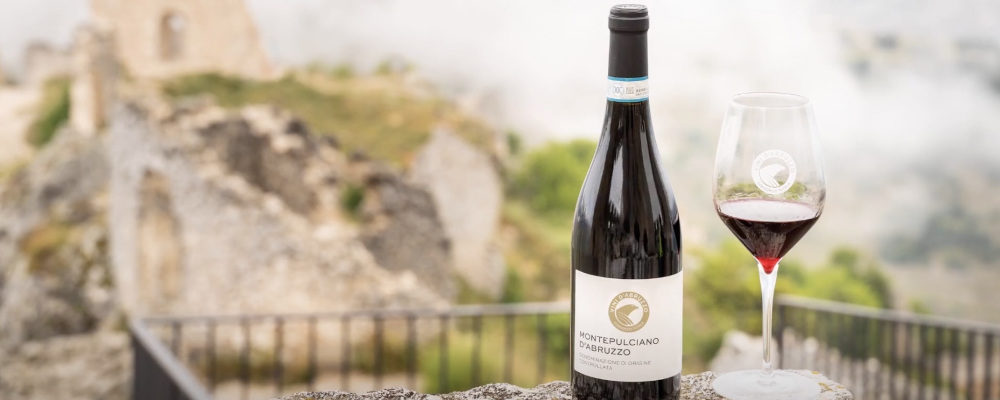The Italian Trade Agency held a tasting in Toronto this week prosaically named Abruzzo: A Land Naturally Suited For Viticulture. The tasting was held at Casa Loma and was modest in size, with just 17 producers from the Consorzio Tutela Vini d’Abruzzo of mostly restaurant destined, or premium quality wines.
The format of the event was what’s called a walk-around, where trade and media tour the room, visiting producers or their importing agents, tasting and spitting wines at each table. It was the first event of this kind that I had attended since March 2020 and it was a welcome reminder of how things were before the pandemic.
The Abruzzo tasting was also a reminder that the principal difference between wine amateurs and wine professionals is access. The pros just get more wine put in front of them. The pros also get more different kinds of wine put in front of them, and wines they might not otherwise think to taste.
As a consumer, I have to confess that I did not spend a lot of time looking at wines from Abruzzo on retail shelves or on restaurant wine lists. My association with the region, until this week, was primarily with cheap and cheerful Montepulciano; great value when made well enough, but maybe not very interesting. That perspective has changed.
The Italian region of Abruzzo is considered culturally in the south of Italy. But if it is, it’s in the north of the south and it possesses the two most desirable geographic attributes for Mediterranean wines: altitude and seaside. Abruzzo’s climate is affected by both cooling breezes from its Adriatic coast and cool mountain weather from the Apennines. The mountains also create a rain shadow, which makes the region relatively dry, and so resistant to disease pressure. In other words, “naturally suited for viticulture” is more than just hyperbole.
Generally, I was impressed with what I tasted and I left wondering if Abruzzo is about to break out and join the growing legion of sought-after Italian wine regions. Or if, as is often the case, I was just a little late to the party.
Here are some wines that impressed me, organized by grape or style: Cerasulo is a rosé, or lighter style wine, made from the Montepulciano grape. None of them were available through standard retail, at least in Ontario, their principal market being restaurants. Accordingly, most were priced between $20 and $50 a bottle.
Trebbiano d’Abruzzo
The Abruzzesi will insist that Trebbiano d’Abruzzo is a completely different varietal from the very widely planted (and not too highly respected) Italian mainstay white grape Trebbiano Toscana. My ampelography is not strong enough to understand how genetically distinct the Abruzzo Trebbiano is from the Tuscan one. What I did understand is that the Ciavolich Fosso Cancelli Trebbiano d’Abruzzo 2015, was a sophisticated and concentrated crisp white with citrus notes and a weight on the palate from extended contact on lees. It’s made by rising star Chiara Ciavolich, and I made a note to look for the name in the future.
Also impressive were two Trebbiani from Terraviva. First the Tenuta Terraviva Mario’s 46 Trebbiano d’Abruzzo Superiore 2018. The name derives, from the age of the vines at vintage and changes accordingly every year, explained Federica Topi, export manager for the Topi family-owned winery. Herbal on the nose, deep concentrated citrus on the palate, and mineral on the finish. My notes are: refreshing and deep. Then, the Tenuta Terraviva MPH Trebbiano d’Abruzzo 2020; a very different wine. Rather than elevation in concrete and old oak, like the Mario 46, the MPH is left on its skins for six months in buried amphora, as they do in Georgia. Then it’s finished, still with skin contact, in stainless steel. This version of Trebbiano Abruzzo was much rounder and texturally interesting with silky, fine sand tannin, balancing citrus and pear fruit.
Pecorino
Pecorino is the steely white grape most strongly associated with Le Marche, the Adriatic province just north of Abruzzo. Nic Tartaglia, of his eponymous winery, soft presses his Pecorino on its skins for a few hours before moving it all over to steel tanks for a cold maceration of three or four more days. The result is the deep yellow Nic Tartaglia Colline Pescaresi Pecorino 2020 and, as his note in the program says, it’s a wine that’s “full-bodied, fresh, [and] quite tasty.” Indeed. It’s a big concentrated white, with grapefruit, lemon notes, and a touch of white flower on the nose. This is a wine I want to take me through a long lunch with a good friend.
Cerasuolo
Nic Tartaglia was pouring his wine at the event, and he explained to me that Cerasuolo is the way Abruzzeri used to make wine for everyday drinking. Cerusuolo, not to be confused with the Sicilian red wine blend by the same name, is what Abruzzo produces as rosé, or roasato.
Tartaglia went on to explain that proper red wine, made from Montepulciano and left on its skins to turn deep ruby red, was reserved for special occasions. This seems about right… or at least mostly right. Certainly, most farmer wines would have been made in glass vessels and without too much skin contact. They would have been made to be drunk young. But I am not sure that old-school Cerasuolo wine was meant to be exported as rosé. Market forces may have been at work in the last decade or so to create modern Cerusuolo d’Abruzzo. Who cares? The Nic Tartaglia Cerasuolo d’Abruzzo 2020 is a gastronomic wine, in the tradition of Tavel, with enough weight to carry over a meal and bring and lively red fruit character. It stood out at the tasting.
Montepulciano d’Abruzzo
Montepulciano d’Abruzzo DOC is the foundation of the region wine making, and, as far as I know, all the producers make it. On the high end, producers will typically make at least two versions. Like the Tuscans, they’ll make an ordinary red wine, and then a Riserva. The reserve will typically get some new oak, and age for three years or more before release, and will often be sourced from a single, prized vineyard.
On the younger, ready to drink side of the Montepulciano d’Abruzzo divide I found the Jasci & Marchesi Montepulciano d’Abruzzo 2019. Jasci & Marchesi are considered pioneers of the push to quality wine production in Abruzzo. They were certified organic in 1972; the first in Italy. Their introductory level Montelpulciano is lovely and absolutely qualifiable with big bright red cherry fruit. If that wine was a kind of Abruzzo version of Dolcetto, then the Jasci & Marchesani Rudhir 2018 continued to echo Piedmont with reminiscences of Nebbiolo; bright red fruit with a substantive, if velvety, tannic base. In other words, wine made for food. Alternatively, the Fattoria La Valentina Montepulciano d’Abruzzo 2018, with darker cherry fruit, a mid-palate weight, and an earthy finish reminded me of good Chianti Classico… but at about half the price.
Among the Riserva wines, the well-established exporter Masciarelli offered the Marina Cvetic Montepuliciano d’Abruzzo Riserva 2017 plays it big with a good seasoning of new French oak. The strength of the fruit in the wine, which runs from dark red to black fruit stands up to the wood. At four years old it felt like it was still very young and getting ready for a long run. On the other hand, the Villa Gemma Montepulciano d’Abruzzo Riserva 2015, which sees elevation in the more subdued Slavonian oak was more brooding and subdued with blue fruit notes and spice and violet in the bouquet. Finally, the Fattoria La Valentina Spelt Montepulciano d’Abruzzo 2017, was another distinct take on the terroir and grape: this time almost Barolo-like in its red cherry mixed with deep tannins; it wants years of ageing as good, and full of promise, as it tasted contemporaneously.
I left the tasting a changed man. I will be looking for the high-end wines of Abruzzo on wine lists and store shelves with interest and no small amount of thirst in the days going forward.
Naturally, the Abruzzo wine consortium has a fancy website with spectacular pictures of the region and much more information on the wines at https://www.vinidabruzzo.it/en/.
Producer websites mentioned in this article are:
https://www.jasciemarchesani.it/en/
https://www.lavalentina.it/en/




